|
Saturday 8 March 2008 saw the second Birmingham meeting of the Writing Equipment
Society, which is the UK group for anyone interested in all aspects of
writing equipment, especially fountain pens. I attended both as a new
WES member and to report on the occasion for Pentrace.
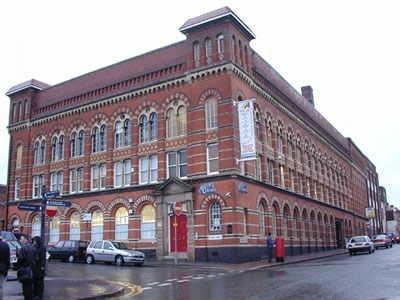
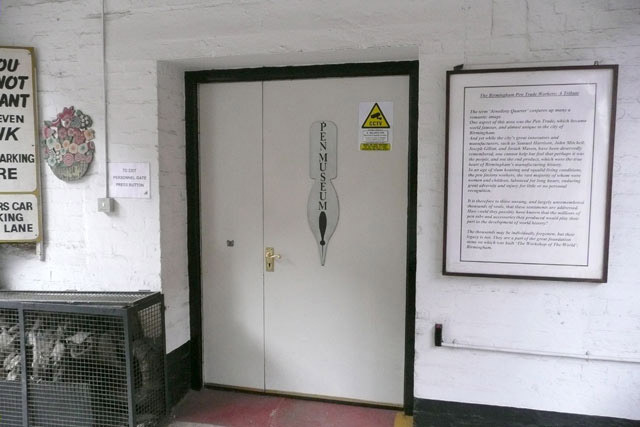
Held in the unique Pen Room museum at the Argent Centre
in Birmingham’s Jewellery Quarter (see
http://www.penroom.co.uk), the meeting had two main aims; firstly
to present a series of lectures by members and guests, and secondly to
celebrate a very special occasion, the formal dedication and opening of
The Philip Poole Room, named in commemoration of one of the best known
founders of the Writing Equipment Society who also helped inspire the
setting up of the Pen Room.

Mr. Brian Jones, Secretary of
the Birmingham Pen Trade Heritage Association
Members of WES and volunteer staff of the Pen Room arrived from 10.30am
and at 11.00am were warmly welcomed by Brian Jones, Secretary of the Birmingham
Pen Trade Heritage Association, and WES Meeting Secretary Dr. Charles
Steiner. Various WES Council members then gave notice of forthcoming events
etc to the members.
MORNING LECTURE: THE STORY OF YARD-O-LED

Mr. Colin Keats, grandson of
company’s founder Ludwig Frederick Brenner
The first lecture of the day was the unique story of The Yard-O-Led Pencil
Co. Ltd, the famous English mechanical pencil and fountain pen manufacturers
which still make top quality writing instruments at their factory in Spencer
Street, Birmingham. Remarkably, this story was told by Colin Keats, grandson
of the company’s founder Ludwig Frederick Brenner.
In the early 1900s Mr. Brenner learned his skills in the jewellery trade
in Pforzheim (in the state of Baden-Württemberg, southwest Germany
at the gate to the Black Forest) a town world-famous for its jewellery
and watch-making industry.
Before the First World War, Brenner settled in England, where from his
premises in City Road, London he introduced a broad range of elegant jewellery
in rolled gold and silver. He went on to establish strong relationships
with many craftsmen and merchants of fine jewellery, becoming highly respected
in the trade. Sadly when war came, Mr. Brenner was interned and lost his
business, but after the cessation of hostilities he developed a new business
and resumed his respected place in the trade, branching out in 1931 when
he founded the Brenner Pocock Pen. Co. in London.
In 1822, the first ever propelling pencil, the Mordan Everpoint, was
invented and patented by Sampson Mordan. Mordan was not directly associated
with Brenner, but in 1934, Frank Tufnell, Junior (whose father had been
a long time associate and employee of Mordan) met Mr. Brenner, a meeting
that was to be of great importance to the history of writing instruments
in later years.
In 1934, Ludwig Frederick Brenner founded The Yard-O-Led Pencil Co. after
patenting a mechanical pencil design which enabled each pencil to hold
twelve 3” leads (or one yard, hence “Yard-O-Led”). However
in practice the leads used were only 2 ¾” long, which meant
the capacity was just short of a yard. The pencils at this time were mostly
made using a silver jacket over a brass and steel mechanism. A variety
were made, including shorter models (“Yard-O-Lettes”) with
ringtops for the ladies and the same size with clips for gentlemen’s
vest pockets. The short model pencils held 2 1/8” leads. The leads
were 3/64” thick. Yard-O-Led pencils became well-known and were
even sold in the United States.
The Second World War brought about many changes. In 1941, at the height
of the London Blitz, both the Mordan factory and the premises of Yard-O-Led
were totally destroyed by German bombs, together with their books and
records. In fact many documents were lost when the safe at Yard-O-Led
was looted, a practice which was not uncommon during the Blitz. Following
this disaster, Ludwig Frederick Brenner and Frank Tufnell, Junior met
again and decided to rebuild the Yard-O-Led Company.
After the war the business was re-started and a new factory was built
in Augusta Street, in what is now part of Birmingham’s “Jewellery
Quarter”. The Sampson Mordan Company patterns were sold, and the
name was acquired by quality pencil manufacturer Edward Baker of Birmingham.
Tufnell purchased a majority shareholding in Yard-O-Led, also buying the
Edward Baker Co., which Yard-O-Led took over in 1955. He was also responsible
for trade sales.
Post-war business was good. Pencils were now made slightly longer in
solid silver and using 3” leads, adding up to a genuine yard. Yard-O-Led
went on to offer a wide range of pencils and pens using materials from
plastic to silver or gold plate, rolled silver, solid silver, rolled gold
and even platinum (only a few items made in the latter). In the 1950s
the advent of the ballpoint pen or “biro” had a big impact
on the trade, even though the early refills were poor, and Yard-O-Led
also produced such pens. The rarest Yard-O-Led ballpoint pen is however
one made of pewter, which apparently was not put into general production,
though Mr. Keats was able to show one borrowed from a collector.
When the Edward Baker Co. moved to a larger factory at Soho Hill, Birmingham,
the Yard-O-Led factory moved into the former Baker premises. The company’s
founder, Ludwig Frederick Brenner (affectionately known as “LFB”)
was still active in the company until 1955, but in 1961 Frank Tuffnell,
Junior became Managing Director of Yard-O-Led, and in 1964 Mr. Brenner
died, at the age of 88, leaving a remarkable legacy. The London offices
moved from Great Cumberland Street to Drummond Street in 1965, and then
in 1972 to East Barnet.
Tim Tufnell, a trained manufacturing jeweller and son of Frank Tuffnell,
Junior, joined Yard-O-Led in the 1970s, and eventually became Managing
Director. Today, Yard-O-Led is owned by Filofax (itself now part of the
Letts Filofax Group). The majority of the company’s pens and pencils
are sold in Great Britain, but also as far afield as the USA, Japan, Russia,
Europe, China and India. The present factory is located in Spencer Street,
just a few hundred yards from the old Augusta Street works. As with many
fountain pen companies today, high quality gold nibs are sourced from
one of the big manufacturers in Germany. However the majority of pen and
pencil production is handled ably by just six highly-skilled craftsmen,
with anything from 2 – 49 years of experience each, who work in
pen and pencil production at Yard-O-Led, and you can be sure that any
quality writing instrument made by the company is produced by time-honoured
methods, including hand-chasing and using engine-turning machines around
a century old.
After being congratulated on his lecture and asked numerous questions
by the audience, Mr. Keats was thanked once again by Dr. Steiner before
the assembly broke up for lunch. During the lunch break time was available
for trading but since most people had gone out for lunch only a few deals
were made.
OPENING OF THE PHILIP POOLE ROOM
Reconvening at 2.15pm, members and guests were called together at the
entrance to the main meeting and learning centre room, which on this occasion
was to be officially dedicated as “The Philip Poole Room”.
The late Mr. Poole at one time ran “His Nibs”, a fascinating
shop in Drury Lane, London, and he was one of the main inspirers of both
the Writing Equipment Society and the Pen Room museum, and so it had been
decided jointly that this was an ideal opportunity to honour a man who
had done so much for both organisations.
The Writing Equipment Society grew from a group of enthusiasts who had
two things in common – they were interested in all the paraphernalia
associated with the act of writing and they all patronized “His
Nibs”. Philip had written informal newsletters to his customers
and friends, pulling together a group which met in London in September
1980, realising that they had the makings of a really worthwhile new society.
So it was that, on 30 November 1980, an inaugural meeting was held in
the Bonnington Hotel, London, and the Writing Equipment Society was born.
It is perhaps less well-known that Philip Poole was also one of the main
inspirations behind the formation and setting up of the Pen Room museum,
which is the home of the Birmingham Pen Trade Heritage Association. The
Association was first formed in September 1996 as an informal meeting
of people interested in the Birmingham pen trade. It was registered as
a charity in 1997. Membership was drawn from former employees of the trade,
collectors and people interested in history. The interest has broadened
over the years to include writing implements and accessories and forms
of writing including Braille and moon, calligraphy and shorthand. The
membership has increased to over 80 and now includes calligraphers, cartoonists
and local people. The Pen Room was opened in April 2001, and a learning
centre and further exhibition was established in what is now The Philip
Poole Room in June 2002.
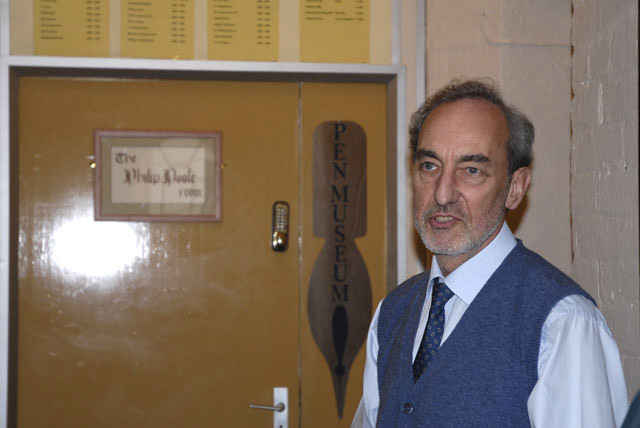
Mr. Philip Poole, Junior
With both WES members and Pen Room volunteers gathered, then, Brian Jones
explained the purpose of the dedication and invited Mr. Poole’s
son, Philip Poole, Junior, to say a few words and to formally open the
room under its new name by unveiling a new sign on the door.
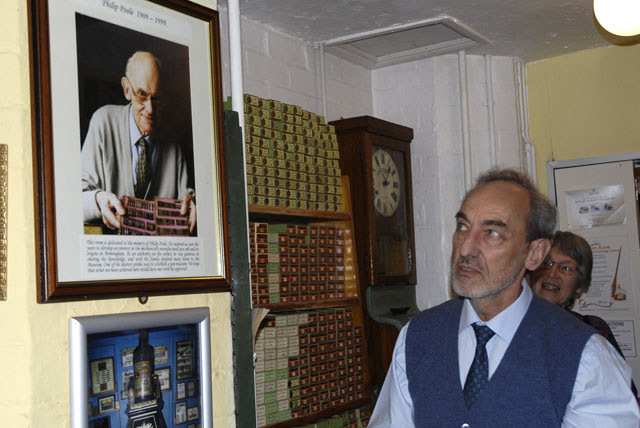
Mr. Poole then went on to unveil a photographic portrait of his father
in the exhibition area of the room.
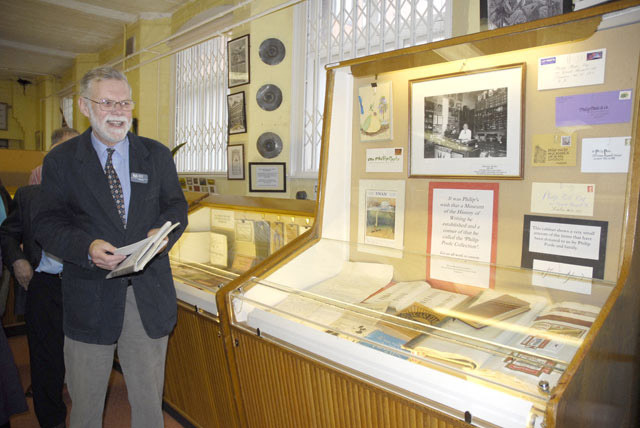
Finally, Mr. Michael Woods, Chairman of WES, formally introduced
a new display cabinet and further display dedicated to Philip Poole, speaking
about Philip Poole and WES as he did so.

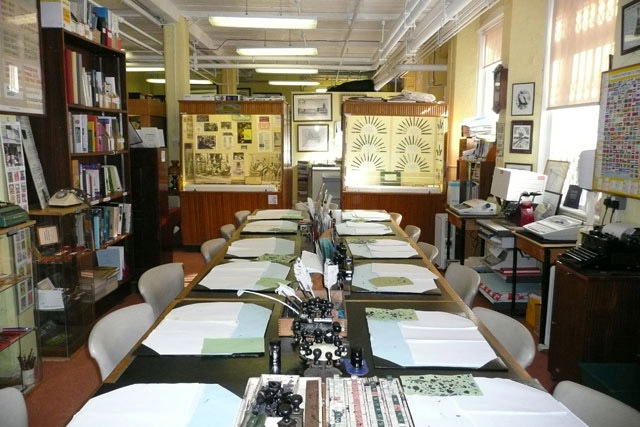
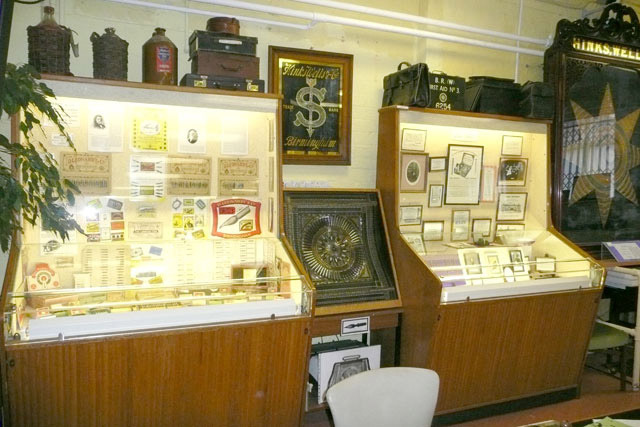
THE AFTERNOON LECTURES
The final half of the day commenced immediately after the
opening of the Philip Poole Room. The first lecture was one to warm a
fountain pen fanaticís heart:
UNUSUAL FILLING SYSTEMS
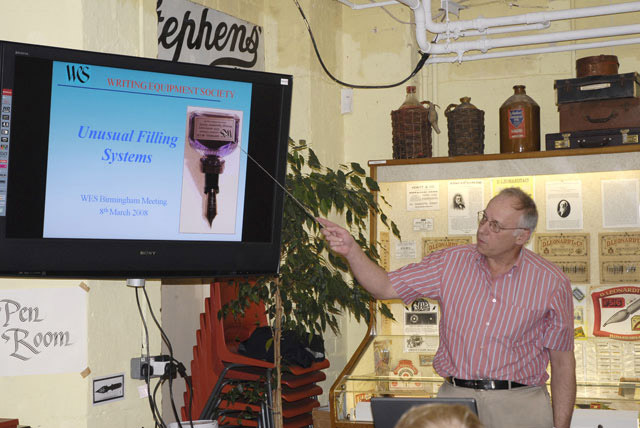
The second speaker of the day was Jeremy Collingridge, who
over the years has developed a thriving fountain pen sales and repair
business. He is also the WES Librarian/Archivist and one of the organisers
both of last year’s WES London Writing Equipment Show and this year’s
new Midland Pen Show in Lichfield (20-22 June 2008, see http://www.midlandpenshow.co.uk).
His lecture was on “Unusual Ink Filling Systems in Fountain Pens”.
After explaining that historically there were literally hundreds of variations
on filling systems, many no longer in use today, he went on to describe
and explain, with photographs and illustrations, a few of the more interesting
and even “classic” ways to get ink into a fountain pen and
(sometimes!) keep it there.
First up was the “Stephens Button Filler”. In this design,
once the blind cap was unscrewed, this became the button for pumping ink
into the pen. It advantage was that it was not possible to lose the blind
cap as a result. Next he described the Conklin Screwed Plunger Filler
and “Word Gauge” system, which enables an approximate count
of words left to write based on a measured indication of ink remaining.
Thirdly, Mr. Collingridge spoke about the “Waterman 88 Jifmatic”,
which worked by simply lifting a flap and crushing the ink sac by hand.
The Japanese “Pilot Switch Filler” seemed a neat solution;
remove the barrel and flip a switch at the end of the inner metal tube,
dip the pen and flip the switch back to fill, then replace the barrel.
A somewhat more obscure variant from a mechanical point of view is the
unusual lever fixing in the “Moore Lever Filler”. In this
a small pin engaged in a tangential hole machined in the barrel. This
made it essential to maintain the associated spring when overhauling such
a pen.
Mr. Collingridge showed a number of fascinating pictures of prototypes
held in the Parker Archive during his talk. One Parker experimental design,
for example, was made to demonstrate a nib similar to that on a Parker
65, but took a Parker 51 cap. Also shown were a Parker experimental bulb
filler, apparently based on a Parker 51. There were also Parker Experimental
Vacumatics, one of which showed a minor variation in design (a rounded
hole in the filler) which would have reduced mechanical stress in the
aluminium speedline filler by a factor of five compared with the lock
down design which went into production. There were also the Parker Capillary
Trials, which went on from the 1940s and in an extraordinary campaign
by Ken Parker and his team produced concept designs for such fillers which
would eventually evolve into the Parker 61 capillary filler and the (shown)
Parker 71 of 1961.
One particularly attractive little pen discussed was the “Wahl
Eversharp Midget Bulb Filler”, a tiny pen which incorporated a bulb
filler in its simplest form, simply a crushable sac. Another, the “Blackbird
Top Fill” was a more engineered version of the Wahl filler, a bulb
filler incorporating a breathing tube. Slightly more familiar was the
“Swan Visofill”, which was similar to the Blackbird but with
a visulated barrel to see the ink content. One simple yet very clever
design was the “Ink Maker Pen” – a modern version of
the Trench Pen. It contained a replaceable “ink battery”,
and the idea was to dip the barrel of the pen into a glass of water and
the ink would dissolve, filling the pen. Also looked at was the “Sheaffer
Pen for Men”, perhaps the ultimate, if over-complicated, evolution
of the Sheaffer Snorkel system whereby a snorkel extends from the pen
to fill then a piston knob is turned to draw in the ink without having
to clean the nib and section. Unfortunately all the mechanics within the
“PFM” mean there was relatively little ink capacity, and its
complexity meant potentially increased need for servicing.
Other examples shown included the Conklin Crescent Fill “Starry”,
the “Cameron Safety Filler” where squeezing the end of the
barrel pressed the filler bar, the “Greishaber Matchstick Filler”
where a matchstick was poked into a hole in the side of the barrel to
compress the sac, and modern representatives of the oft-decried cartridge
filler, notably the Montblanc Boheme, and the Waterman Glass Cartridge,
whose patent went back to 1935 but was still in use in the 1950s.
The lecture was warmly received, many questions asked, and some of the
systems illustrated were viewed with amusement as you might expect!
And finally…
UNUSUAL MATERIALS
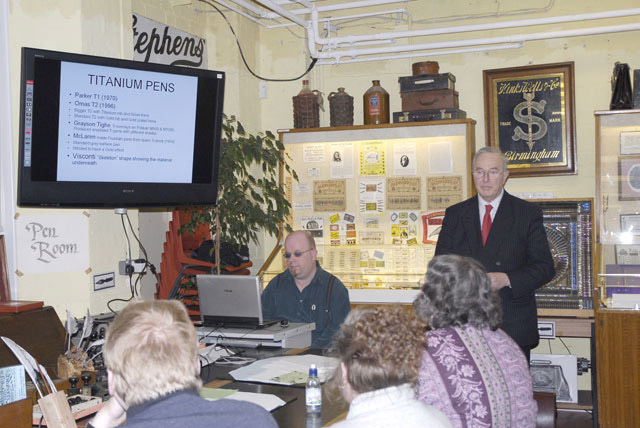
Dr. Charles Steiner, WES Meeting
Secretary
Dr. Charles Steiner has had a lifetime of experience in metallurgy, and
after thanking Jeremy Collingridge, went on to speak on his own behalf
in the afternoon’s second and final lecture, about “The use
of unusual materials in the manufacture of writing instruments”.
He gave particular examples of a number of fountain pens and in some
cases nibs, made from materials as diverse as platinum, palladium, titanium
and carbon fibre.
The first titanium fountain pen was the Parker T1 of 1970. It was followed
in 1996 by the Omas T2, of which there were two versions, one of which
was larger with a titanium nib and silver trim. The standard T2, a slightly
smaller pen, had a gold nib and gold plated trim. Other titanium pens
produced have included special pens made by Grayson Tighe in numbered
editions based on the Pelikan M800 and M1000; these pens were anodised
giving different shades or colours of metal. Some current Tighe pens use
carbon fibre overlaid on titanium. Motor racing company McLaren have also
produced pens made from spare titanium tube stock and carbon fibre. Chris
Thompson has produced some fine “vintage” Parker Duofold replicas
from machined titanium bar stock and using modern Duofold gold nibs. The
Visconti Skeleton Demonstrator is a startling limited edition pen which
uses a titanium skeleton overlain over a transparent body, offering a
pen which changes colour according to the ink with which it is filled.
Finally, less exotic but more affordable is the Lamy Persona, a fine modern
pen which in one form has a titanium finish which could be either vacuum
deposited or electroplated.
Why use titanium? Although expensive, it is less so than in the past
and is widely distributed in mineral form (i.e. Rutile or Ilmenite), although
it can be difficult to isolate. It is very hard and resistant to discolouration
or corrosion, including that caused by bodily fluids or inks. It is tough
and shock-resistant. It can be worked into shape hot or cold. On the other
hand it can be difficult to handle and work, being tougher than steel
tools - one of the main reasons for the commercial failure of the Parker
T1 was the fact that it cost so much to manufacture. The titanium simply
wore out the conventional metalworking tools of the day.
Some pens have also been made out of Platinum, although because this
often dulls many have been overplated. Platinum is four times as expensive
as palladium, is 2 or 3 times denser than steel, and its discovery dates
back to pre-Columbian times. Its use was in decline until World War II,
after which there was an upsurge in use. It is very unusual for solid
platinum pens to be made; normally manufacture involves a thin vacuum
deposited or electroplated coating of platinum over the main body (brass?)
and the platinum may then be coated with palladium or rhodium. Companies
making pens which use platinum have included Montblanc, Cartier, and Yard-O-Led
(who made just 3 ballpoints from this!). Montblanc also uses platinum
in the nibs for its 149 fountain pens.
Finally, carbon fibre, a synthetic material which is stronger than steel,
is also used in the bodies of a number of pens, usually in combination
with other materials. Dunhill produced the first carbon fibre pen in 1996
– the “AD2000”. Carbon fibre has also been used in the
Delta Extrema, and in selected pens by Montblanc, McLaren, Monteverde
and in the Caran D’Ache Octagonal.
After applause and a series of interested technical questions, Dr. Steiner
was thanked for his most informative lecture and the meeting concluded
around 3.30pm, the members and guests departing to wend their weary way
home. Your Ace Reporter likewise headed off hotfoot to Birmingham New
Street Railway Station for the train back to Bloxwich, and a well-earned
cup of coffee!
What next for WES? A meeting of the Writing Equipment Society will be
held on Saturday 19 April 2008, 3pm, at the Clifton Arms Hotel, Lytham
St. Annes, England. For more information see the WES website: http://www.wesonline.org.uk
and don’t forget – new members are always welcome!
Stuart Williams, 13 March 2008
© 2008 Stuart Williams All rights reserved
by author
Read Stuart William’s previous article
The
Birmingham Pen Room
Pen Room Museum at the Argent Centre in Birmingham’s Jewellery
Quarter
http://www.penroom.co.uk
Writing Equipment Society
http://www.wesonline.org.uk
|